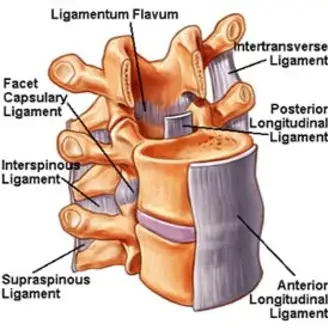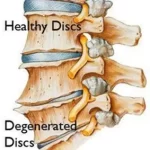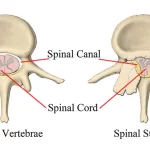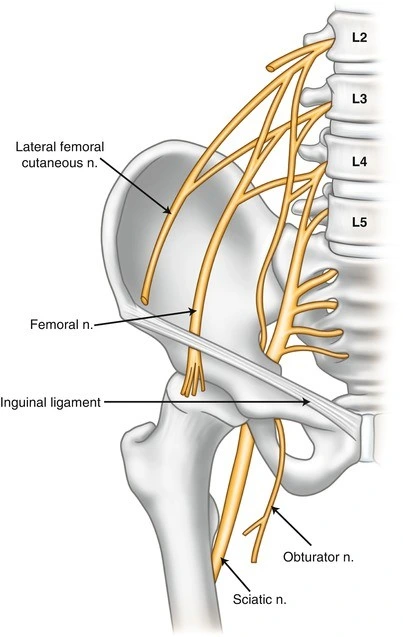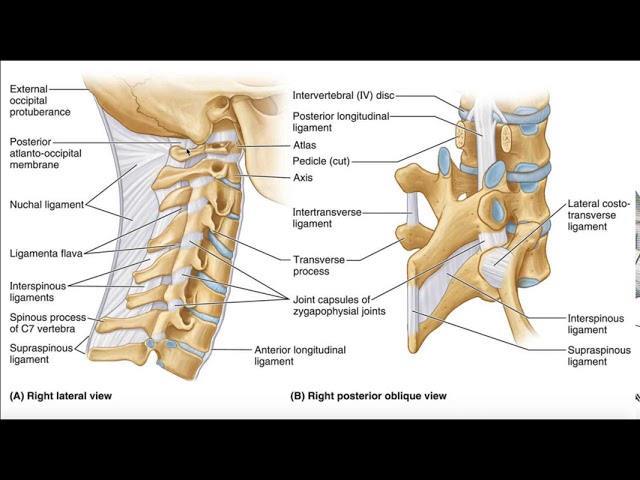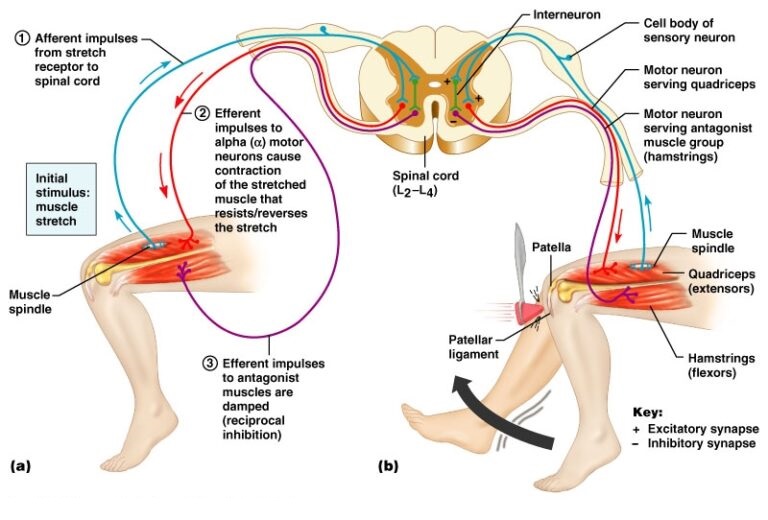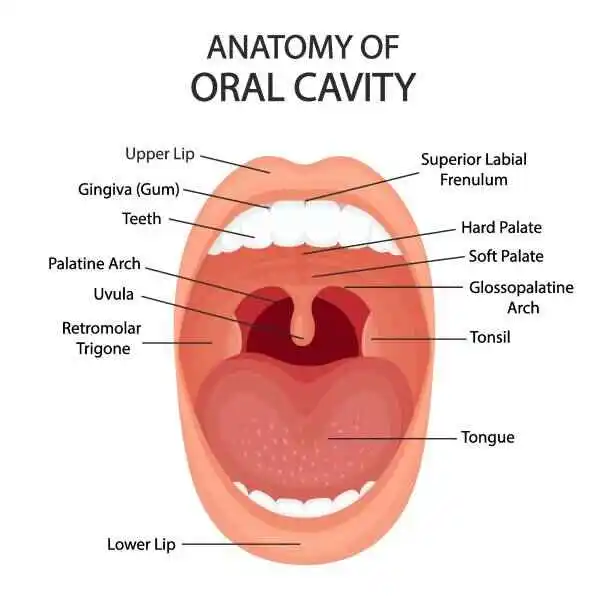Anterior Longitudinal Ligament
Table of Contents
Introduction
The anterior longitudinal ligament is a strong band of connective tissue that runs down the front of the vertebral bodies in the spinal column. It helps to support and stabilize the spine, preventing excessive movement and protecting against injury.
The ligament is an important component of the spinal column and plays a crucial role in maintaining proper posture and alignment of the spine. Injuries to the anterior longitudinal ligament can cause pain, weakness, and instability in the spine, making it difficult to perform daily activities.
Structure of the anterior longitudinal ligament
The anterior longitudinal ligament is a long, thin band of connective tissue that runs down the front of the vertebral bodies in the spinal column. It originates at the base of the skull and continues down to the sacrum, where it attaches to the pelvic bone. The ligament is composed of dense, fibrous tissue that is strong and flexible.
The ligament is divided into three parts: cervical, thoracic, and lumbar. The cervical portion runs from the base of the skull to the top of the thoracic spine, while the thoracic portion runs from the top of the thoracic spine to the bottom of the lumbar spine. The lumbar portion runs from the bottom of the lumbar spine to the sacrum.
The anterior longitudinal ligament is located on the front (anterior) side of the spinal column and is in close proximity to the spinal cord and nerve roots. It helps to support and stabilize the spine by preventing excessive movement between adjacent vertebral bodies. The ligament also helps to maintain proper posture and alignment of the spine.
Injuries to the anterior longitudinal ligament can occur as a result of trauma, such as a car accident or fall. Symptoms of an injury may include pain, weakness, and instability in the spine. Treatment for an anterior longitudinal ligament injury may include rest, physical therapy, and in severe cases, surgery.
In general, the anterior longitudinal ligament is an important component of the spinal column that plays a crucial role in supporting and stabilizing the spine, maintaining proper posture and alignment, and protecting against injury.
Attachment of the Anterior Longitudinal Ligament
The anterior longitudinal ligament attaches to the vertebral bodies of the spinal column. It originates at the base of the skull and runs down the entire length of the spinal column, ending at the sacrum. The ligament attaches to the front (anterior) side of each vertebral body, starting from the C1 vertebra in the cervical spine and ending at the S1 vertebra in the sacrum.
The ligament is firmly attached to the vertebral bodies through Sharpey’s fibers, which are small collagen fibers that anchor the ligament to the bone. These fibers extend from the ligament into the outer layer of the bone, providing a strong and stable attachment.
In addition to attaching to the vertebral bodies, the anterior longitudinal ligament also attaches to the intervertebral discs. These discs are located between adjacent vertebral bodies and act as shock absorbers for the spine. The ligament attaches to the front of each disc, helping to stabilize and support them.
At the lower end of the spinal column, the anterior longitudinal ligament attaches to the pelvic bone. Specifically, it attaches to the pubic symphysis, which is a joint between the two pelvic bones. This attachment helps to provide stability and support for the lower back and pelvis.
So in the end, the attachment of the anterior longitudinal ligament is essential for maintaining proper alignment and stability of the spinal column. Its strong and stable attachment to the vertebral bodies, intervertebral discs, and pelvic bone helps to prevent excessive movement and protect against injury.
Functions of the Anterior Longitudinal Ligament
The anterior longitudinal ligament (ALL) is a thick band of connective tissue that runs down the front of the vertebral bodies, from the base of the skull to the sacrum. It plays an important role in stabilizing the spine and preventing excessive motion between vertebrae. Some of the key functions of the anterior longitudinal ligament are:
- Limiting spinal extension: The anterior longitudinal ligament is taut when the spine is in extension, which helps limit excessive backward bending of the spine. This is important for preventing injury to the spinal cord and nerve roots that run through the spinal canal.
- Providing stability during flexion: When the spine is flexed forward, the anterior longitudinal ligament becomes slack and allows the vertebral bodies to move closer together. However, it still provides some stability and helps prevent excessive forward bending of the spine.
- Supporting the weight of the head: The anterior longitudinal ligament attaches to the base of the skull and helps support the weight of the head. This is important for maintaining proper alignment of the cervical spine and preventing strain on the neck muscles.
- Preventing excessive lateral bending: The anterior longitudinal ligament also helps limit side-to-side bending of the spine, which can cause compression of the intervertebral discs and nerve roots.
- Protecting the spinal cord: Finally, the anterior longitudinal ligament helps protect the spinal cord from injury by limiting excessive motion between vertebrae and providing a barrier against external forces.
Overall, the anterior longitudinal ligament is an important structure for maintaining stability and protecting the spinal cord and nerve roots. It works in conjunction with other ligaments, muscles, and bones to keep the spine functioning properly and prevent injury.
Blood supply of the Anterior Longitudinal Ligament
The anterior longitudinal ligament (ALL) receives its blood supply from several sources. The blood vessels that supply the anterior longitudinal ligament include the anterior spinal artery, segmental arteries, and basivertebral veins.
The anterior spinal artery is the main source of blood supply for the anterior longitudinal ligament. It runs along the front of the spinal cord and sends branches off to the anterior longitudinal ligament as it descends down the spine. The anterior spinal artery is responsible for supplying oxygen and nutrients to the anterior longitudinal ligament, as well as removing waste products.
Segmental arteries also play a role in supplying blood to the anterior longitudinal ligament. These arteries branch off from the aorta and run along the sides of the vertebral bodies. They send branches off to the anterior longitudinal ligament as they pass by, providing additional blood supply to the ligament.
Finally, the basivertebral veins also contribute to the blood supply of the anterior longitudinal ligament. These veins run along the inside of the vertebral bodies and drain blood from the anterior longitudinal ligament and other structures in the spine. While they do not directly supply blood to the anterior longitudinal ligament, they help maintain proper circulation by removing deoxygenated blood and waste products.
Overall, the blood supply of the anterior longitudinal ligament is important for maintaining its health and function. Without adequate blood flow, the ligament may become weakened or damaged, leading to instability in the spine and an increased risk of injury.
Pathology of the Anterior Longitudinal Ligament
The anterior longitudinal ligament (ALL) can be affected by various pathologies that can lead to pain and dysfunction in the spine. Some of the common pathologies of the anterior longitudinal ligament include:
Sprains and strains: The anterior longitudinal ligament can be sprained or strained due to sudden trauma or repetitive stress. This can cause pain, inflammation, and stiffness in the spine.
Herniated disc: A herniated disc can put pressure on the anterior longitudinal ligament and cause it to bulge or tear. This can result in pain, weakness, and numbness, in the injured area.
Degenerative disc disease: As we age, the discs in our spine can degenerate and lose their ability to absorb shock. This can cause the anterior longitudinal ligament to become stiff and less flexible, leading to pain and stiffness in the spine.
Osteoarthritis: Osteoarthritis is a condition that causes the joints in the spine to degenerate and become inflamed. This can affect the anterior longitudinal ligament and cause it to become stiff and painful.

Ankylosing spondylitis: Ankylosing spondylitis is a type of arthritis that has an impact on the spine. It can cause the anterior longitudinal ligament to become inflamed and stiff, leading to pain and stiffness in the spine.
Spinal stenosis: Spinal stenosis is a condition because of which the spinal canal gets narrows, creating pressure on the nerves in the spine. This can affect the anterior longitudinal ligament and cause it to become stiff and painful.
It is very necessary to take medical attention if you feel persistent pain or dysfunction in your spine.
Symptoms of the Anterior Longitudinal Ligament Injury
The symptoms of anterior longitudinal ligament pathologies can vary depending on the underlying condition. However, some common symptoms of anterior longitudinal ligament pathologies include:
- Pain: Pain is the most common symptom of anterior longitudinal ligament pathologies. The pain can be dull or sharp and may be felt in the neck, back, or both.
- Stiffness: Stiffness in the spine is another common symptom of anterior longitudinal ligament pathologies. The stiffness can make it difficult to move the spine and may be worse in the morning or after sitting for a long time.
- Numbness and tingling: If a herniated disc is putting pressure on the anterior longitudinal ligament, it can cause numbness and tingling in the arms or legs.
- Weakness: Weakness in the arms or legs can also occur if a herniated disc is putting pressure on the anterior longitudinal ligament.
- Limited range of motion: Limited range of motion in the spine can occur due to stiffness and pain in the anterior longitudinal ligament.
- Difficulty standing or walking: Spinal stenosis can cause difficulty standing or walking due to pressure on the nerves in the spine.
- Loss of bladder or bowel control: In severe cases, pressure on the nerves in the spine can cause loss of bladder or bowel control.
It is very essential to take medical attention if you experience any of these symptoms, as they may indicate a serious underlying condition.
Diagnosis
Diagnosis of ALL (Anterior Longitudinal Ligament) pathology involves a thorough evaluation of the patient’s medical history, physical examination, and imaging tests.
Medical History: The doctor will ask about the patient’s symptoms, including pain, stiffness, weakness, or numbness in the neck or back. They may also ask about any previous injuries or medical conditions that could be contributing to the symptoms.
Physical Examination: The doctor will perform a physical examination to assess the patient’s range of motion, muscle strength, and reflexes. They may also check for signs of inflammation or tenderness along the spine.
Imaging Tests: Imaging tests such as X-rays, MRIs, or CT scans are used to get a detailed look at the spine and identify any abnormalities. X-rays can show changes in bone structure, while MRIs and CT scans can reveal soft tissue damage or nerve compression.
Blood Tests: Blood tests may be ordered to check for signs of inflammation or infection that could be contributing to the symptoms.
Biopsy: In some cases, a biopsy may be necessary to determine the underlying cause of the anterior longitudinal ligament pathology. A small sample of tissue is taken from the injured area and examined under a microscope.
Spinal Tap: A spinal tap may be necessary to check for signs of infection or other conditions that could be causing the symptoms.
Overall, a combination of these diagnostic methods is used to determine the underlying cause of the anterior longitudinal ligament pathology and develop an appropriate treatment plan. Early diagnosis and treatment can help prevent further damage to the spine and improve the quality of life for those affected by the condition.
Treatment of the Anterior Longitudinal Ligament Injury
Conservative treatment
Conservative treatment of ALL (Anterior Longitudinal Ligament) pathology involves non-surgical methods to manage the symptoms and improve the patient’s quality of life. Conservative treatment options for the anterior longitudinal ligament may include:
- Pain Management: The doctor may prescribe pain medications or recommend over-the-counter pain relievers to manage the pain associated with the anterior longitudinal ligament. Physical therapy, massage therapy, or chiropractic care may also be recommended to help reduce pain and stiffness.
- Rest and Activity Modification: The patient may need to rest and avoid activities that aggravate the symptoms. The doctor may recommend modifying daily activities and providing supportive devices such as a neck brace or back brace.
- Exercise and Stretching: The doctor may recommend specific exercises and stretching routines to help strengthen the muscles around the spine and improve flexibility.
- Weight Management: Maintaining a healthy weight can help reduce stress on the spine and improve overall health.
- Anti-inflammatory Medications: The doctor may recommend anti-inflammatory medications or corticosteroid injections to reduce inflammation and swelling in the affected area.
- Acupuncture: Acupuncture is a complementary therapy that involves inserting thin needles into specific points on the body to alleviate pain and promote healing.
- Lifestyle Changes: The doctor may recommend making lifestyle changes such as quitting smoking, reducing alcohol intake, and improving posture to help manage anterior longitudinal ligament symptoms.
Overall, conservative treatment options for the anterior longitudinal ligament focus on managing symptoms, reducing inflammation, and improving overall health. The doctor will work with the patient to develop an individualized treatment plan based on their specific needs and medical history.
Physiotherapy treatment
Physiotherapy treatment of Anterior Longitudinal Ligament (ALL) pathology involves a range of exercises and techniques designed to improve the patient’s mobility, strength, and flexibility. The physiotherapist will work with the patient to develop an individualized treatment plan based on their specific needs and medical history. Here are some of the common physiotherapy treatments for the anterior longitudinal ligament:
Manual Therapy: Manual therapy techniques such as massage, mobilization, and manipulation are used to help reduce pain and stiffness in the affected area. The therapist may use their hands or special tools to apply pressure to specific areas of the spine.
Exercise Therapy: Exercise therapy is an essential component of physiotherapy treatment for the anterior longitudinal ligament. The therapist will design a customized exercise program to help improve the patient’s strength, flexibility, and mobility. The exercises may involve strengthening, range of motion exercises, and stretching exercises.
Posture Correction: Poor posture can put extra stress on the spine, exacerbating anterior longitudinal ligament symptoms. The physiotherapist will work with the patient to correct their posture and provide advice on how to maintain good posture throughout the day.
Electrical Stimulation: Electrical stimulation is a technique that uses electrical currents to stimulate the muscles around the spine. This can help in reducing pain and improving muscle function.
Heat and Cold Therapy: Heat and cold therapy are often used in combination with other physiotherapy treatments to reduce pain and inflammation in the affected area.
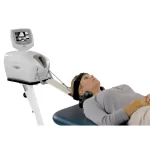
Traction: Traction involves applying a gentle pulling force to the spine to help relieve pressure on the affected area. This can help in reducing pain and improving mobility.
Education: The physiotherapist will provide education on how to manage anterior longitudinal ligament symptoms, including advice on how to avoid activities that aggravate the condition and how to maintain good spinal health.
So in the end we can say that physiotherapy treatment of the anterior longitudinal ligament is designed to improve the patient’s quality of life by reducing pain, improving mobility, and promoting healing. The treatment plan will be tailored to the patient’s specific needs and may involve a combination of different techniques and exercises.
Risk factors
Anterior Longitudinal Ligament (ALL) pathology can be caused by a variety of risk factors, including:
- Age: As we age, our ligaments get less elastic and more prone to the risk of injury. anterior longitudinal ligament pathology is more common in older adults.
- Trauma: Trauma to the spine, such as a fall or car accident, can cause damage to the anterior longitudinal ligament.
- Poor Posture: Poor posture can put extra stress on the spine, causing the anterior longitudinal ligament to become strained or damaged over time.
- Repetitive Strain: Repetitive strain on the spine, such as lifting heavy objects or performing repetitive motions, can cause wear and tear on the anterior longitudinal ligament.
- Obesity: Excess weight can put extra pressure on the spine, leading to strain on the anterior longitudinal ligament.
- Genetics: Some people may be more prone to developing anterior longitudinal ligament pathology due to genetic factors.
- Osteoporosis: Osteoporosis, a condition characterized by weak and brittle bones, can increase the risk of anterior longitudinal ligament pathology.
- Inflammatory Conditions: Inflammatory conditions such as rheumatoid arthritis can cause inflammation and damage to the anterior longitudinal ligament.
- Spinal Surgery: Spinal surgery can increase the risk of anterior longitudinal ligament pathology due to the trauma and strain placed on the ligament during the procedure.
It is important to note that not everyone with these risk factors will develop anterior longitudinal ligament pathology, and some people without any of these risk factors may still develop the condition. However, understanding these risk factors can help individuals take steps to reduce their risk of developing anterior longitudinal ligament pathology.
How to prevent injuries of the Anterior Longitudinal Ligament?
Preventing injuries to the Anterior Longitudinal Ligament (ALL) involves taking steps to reduce the risk factors that can lead to its pathology. Here are some ways to prevent injuries to the anterior longitudinal ligament:
- Maintain good posture: Maintaining good posture can help reduce stress on the spine and prevent strain on the anterior longitudinal ligament. This can be achieved by sitting and standing up straight, keeping the shoulders back, and avoiding slouching.
- Exercise regularly: Regular exercise can help strengthen the muscles that support the spine, reducing the risk of injury to the anterior longitudinal ligament. Exercises that focus on core strength, such as yoga or Pilates, can be especially helpful.
- Lift objects properly: When lifting heavy objects, it is important to use proper lifting techniques to avoid straining the anterior longitudinal ligament. This involves bending at the knees, keeping the back straight, and using the legs to lift the object rather than the back.
- Maintain a healthy weight: Excess weight creates excessive pressure on the spine, increasing the risk of injury to the anterior longitudinal ligament. Maintaining a healthy weight through diet and exercise can help in reducing this risk.
- Avoid repetitive motions: Repetitive motions, such as those involved in certain jobs or sports, can put a strain on the anterior longitudinal ligament over time. Taking breaks and stretching regularly can help reduce this risk.
- Treat underlying conditions: Treating underlying conditions such as osteoporosis or inflammatory conditions can help reduce the risk of injury to the anterior longitudinal ligament.
- Avoid smoking: Smoking can weaken bones and increase the risk of osteoporosis, which in turn can increase the risk of anterior longitudinal ligament pathology.
By taking these steps, individuals can reduce their risk of developing injuries to the Anterior Longitudinal Ligament (ALL) and maintain a healthy spine.
FAQ
The Anterior Longitudinal Ligament (ALL) is a strong band of connective tissue that runs along the front of the spinal column, providing support and stability to the spine.
Injury to the Anterior Longitudinal Ligament can be caused by trauma, such as a car accident or fall, or by repetitive strain, such as lifting heavy objects or performing certain sports or job-related activities.
Symptoms of Anterior Longitudinal Ligament injuries can include back pain, stiffness, and limited range of motion. In severe cases, there may be spinal instability or nerve damage.
Anterior Longitudinal Ligament injury is typically diagnosed through a physical exam, imaging tests such as X-rays or MRI, and possibly a CT scan.
Treatment for Anterior Longitudinal Ligament injuries depends on the severity of the injury. Mild cases may be treated with rest, ice, and physical therapy, while more severe cases may require surgery to repair or replace the damaged ligament.
Yes, Anterior Longitudinal Ligament injuries can be prevented by maintaining good posture, exercising regularly, lifting objects properly, maintaining a healthy weight, avoiding repetitive motions, treating underlying conditions, and avoiding smoking.

